The Nervous System and the Endocrine System
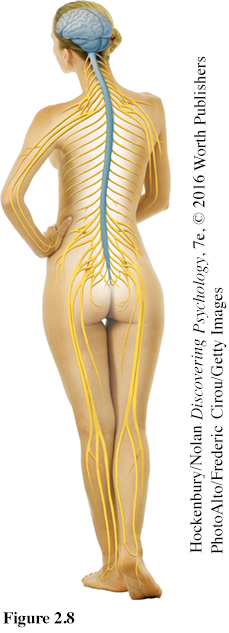
COMMUNICATION THROUGHOUT THE BODY
KEY THEME
Two major communication systems in the body are the nervous system and the endocrine system.
KEY QUESTIONS
What are the divisions of the nervous system, and what are their functions?
How is information transmitted in the endocrine system, and what are its major structures?
How do the nervous and endocrine systems interact to produce the fight-
or- flight response?
Specialized for communication, up to 1 trillion neurons are linked throughout your body in a complex, organized communication network called the nervous system. The human nervous system is divided into two main divisions: the central nervous system and the peripheral nervous system (see Figure 2.8). For even simple behaviors to occur, such as curling your toes or scratching your nose, these two divisions must function as a single, integrated unit. Yet each of these divisions is highly specialized and performs different tasks.
The neuron is the most important transmitter of messages in the central nervous system. In the peripheral nervous system, communication occurs along nerves. Nerves and neurons are not the same thing. Nerves are made up of large bundles of neuron axons. Unlike neurons, many nerves are large enough to be seen easily with the unaided eye.
The Central Nervous System
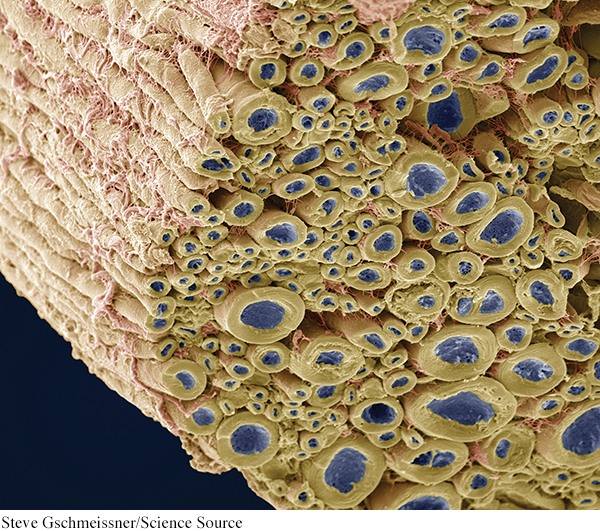
The central nervous system (CNS) includes the brain and the spinal cord. The central nervous system is so critical to your ability to function that it is entirely protected by bone—
The central nervous system is aptly named. It is central to all your behaviors and mental processes. And it is the central processing center—
The spinal cord handles both incoming and outgoing messages. Sensory receptors send messages along sensory nerves to the spinal cord, then up to the brain. To activate muscles, the brain sends signals down the spinal cord which are relayed out along motor nerves to the muscles.

IN FOCUS
Traumatic Brain Injury: From Concussions to Chronic Traumatic Encephalopathy
Although encased in bone and cushioned by cerebrospinal fluid, the brain is highly susceptible to injury. Just a quarter inch of bone and membranes protect the brain from harm. A sharp blow to the head or body can cause the brain to literally crash into the skull. The shock wave from an explosion, such as a bomb blast, can also violently jar the brain, even when the head is protected by a helmet or other protective headgear. Thus, someone who experiences a close encounter with an intense explosion may appear to be unhurt, yet still have a severe brain injury (Sponheim & others, 2011).
When such an event disrupts normal brain functioning, a traumatic brain injury (or TBI) may be diagnosed. A concussion is the most common, and mildest, type of TBI, affecting more than 1 million people every year in the United States alone (Rabinowitz & others, 2014). Along with bomb blasts experienced by people in war zones, other common causes of concussion are auto accidents, falls, and sports injuries.
Traditionally, concussion has been defined as a disruption of normal functioning that occurs in the absence of any discernible structural or physical damage to the brain. However, we know now that concussions can cause physical damage and disrupt many aspects of brain function. As the brain twists or bounces, axons are sheared, myelin damaged, and brain chemistry disrupted. Although damage may not be evident on a CAT or MRI scan, it’s obvious in the behavioral manifestations of concussion: loss of consciousness, dizziness, blurred or double vision, slurred speech and memory loss, among others (Rabinowitz & others, 2014).
Most people recover from concussions without complications. However, repeated concussions can lead to a serious brain disease called chronic traumatic encephalopathy, or CTE. CTE is a progressive, degenerative brain disease that can only be diagnosed after death. Symptoms include depression and anxiety, poor judgment and lack of impulse control, and problems with memory, concentration, and attention. Ultimately, CTE leads to dementia and death (Gavett & others, 2011).
Increasingly, CTE has been diagnosed in professional athletes, especially football and hockey players. For example, consider the case of Dave Duerson (see photo). After leaving the NFL, Dave Duerson became a successful businessman and spokesperson for the NFL players union. But as the years went by, his emotions and behavior became more erratic. His business failed and so did his once-

Just before shooting himself in the chest, Duerson texted his ex-
Duerson and the other pro athletes with CTE were known to have suffered multiple concussions. But some researchers now suspect that CTE can result from milder brain injuries. Thomas Owens was a popular, academically successful 21-
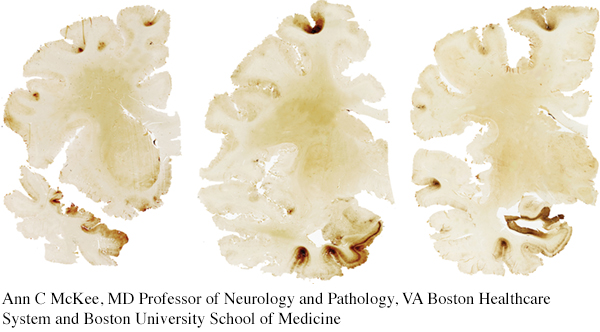
Most behaviors are controlled by your brain. However, the spinal cord can produce spinal reflexes—simple, automatic behaviors that occur without any brain involvement. For example, the withdrawal reflex occurs when you touch a painful stimulus, such as something hot, electrified, or sharp. As you can see in Figure 2.9, this simple reflex involves a loop of rapid communication among sensory neurons, which communicate sensation to the spinal cord; interneurons, which relay information within the spinal cord; and motor neurons, which signal the muscles to react.
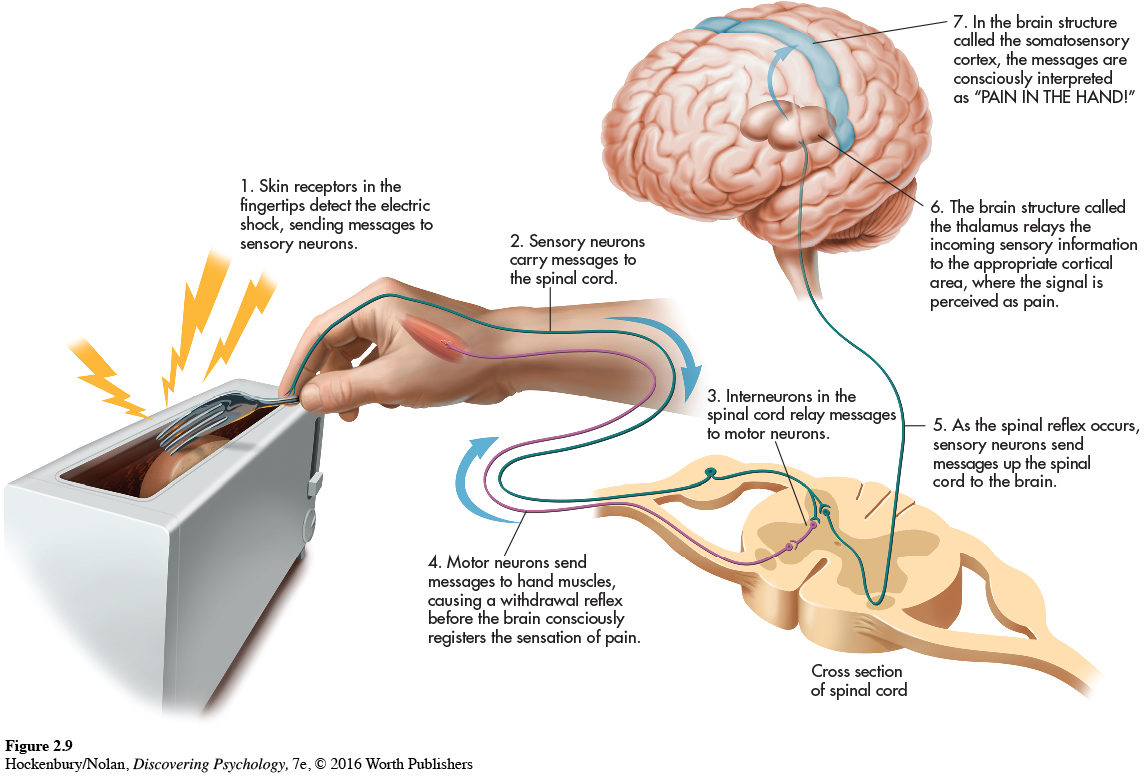
Spinal reflexes are crucial to your survival. The additional few seconds that it would take you to consciously process sensations and decide how to react could result in serious injury. Spinal reflexes are also important as indicators that the neural pathways in your spinal cord are working correctly. That’s why physicians test spinal reflexes during neurological examinations by tapping just below your kneecap for the knee-
The Peripheral Nervous System
The peripheral nervous system is the other major division of your nervous system. The word peripheral means “lying at the outer edges.” Thus, the peripheral nervous system comprises all the nerves outside the central nervous system that extend to the outermost borders of your body, including your skin. The communication functions of the peripheral nervous system are handled by its two subdivisions: the somatic nervous system and the autonomic nervous system.
The somatic nervous system takes its name from the Greek word soma, which means “body.” It plays a key role in communication throughout the entire body. First, the somatic nervous system communicates sensory information received by sensory receptors along sensory nerves to the central nervous system. Second, it carries messages from the central nervous system along motor nerves to perform voluntary muscle movements. All the different sensations that you’re experiencing right now are being communicated by your somatic nervous system to your spinal cord and on to your brain. When you perform a voluntary action, such as turning a page of this book, messages from the brain are communicated down the spinal cord, and then out to the muscles via the somatic nervous system.
The other subdivision of the peripheral nervous system is the autonomic nervous system. The word autonomic means “self-
However, the autonomic nervous system is not completely self-
The involuntary functions regulated by the autonomic nervous system are controlled by two different branches: the sympathetic and parasympathetic nervous systems. These two systems control many of the same organs in your body but cause them to respond in opposite ways (see Figure 2.10). In general, the sympathetic nervous system arouses the body to expend energy, and the parasympathetic nervous system helps the body conserve energy.
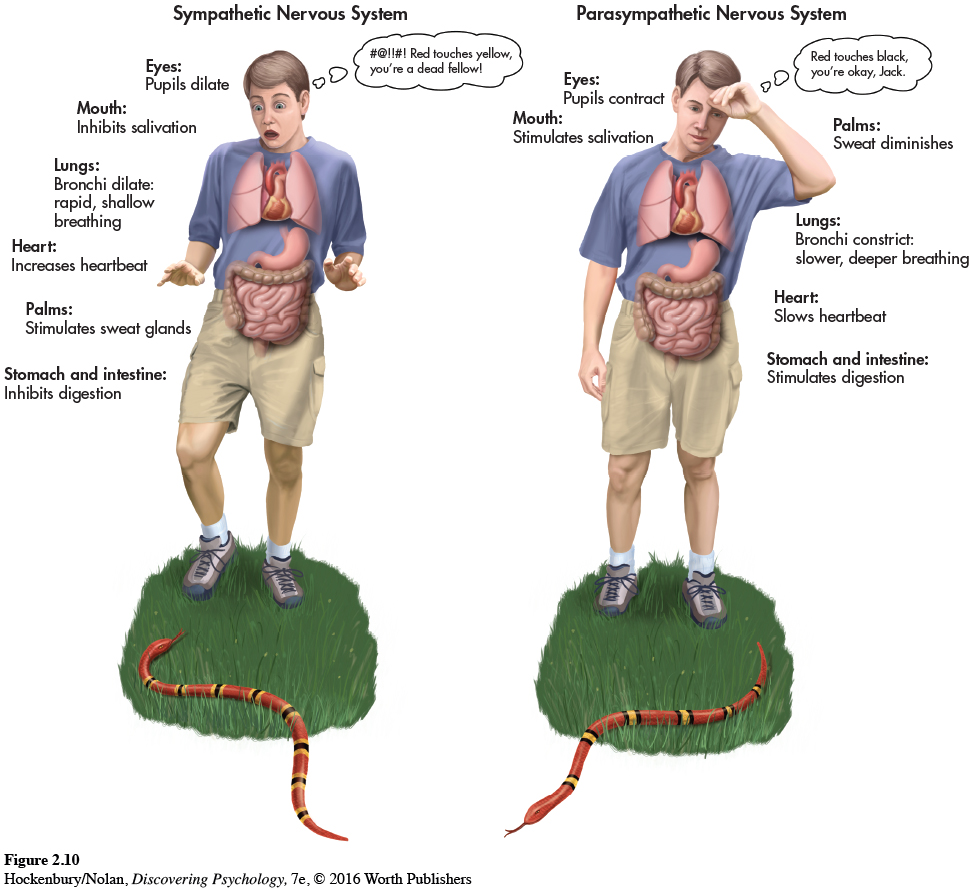

The sympathetic nervous system is the body’s emergency system, rapidly activating bodily systems to meet threats or emergencies. When you are frightened, your breathing accelerates, your heart beats faster, digestion stops, and the bronchial tubes in your lungs expand. All these physiological responses increase the amount of oxygen available to your brain and muscles. Your pupils dilate to increase your field of vision, and your mouth becomes dry, because salivation stops. You begin to sweat in response to your body’s expenditure of greater energy and heat. These bodily changes collectively represent the fight-
Whereas the sympathetic nervous system mobilizes your body’s physical resources, the parasympathetic nervous system conserves and maintains your physical resources. It calms you down after an emergency. Acting much more slowly than the sympathetic nervous system, the parasympathetic nervous system gradually returns your body’s systems to normal. Heart rate, breathing, and blood pressure level out. Pupils constrict back to their normal size. Saliva returns, and the digestive system begins operating again.
Although the sympathetic and parasympathetic nervous systems produce opposite effects, they act together, keeping the nervous system in balance (see Figure 2.11). Each division handles different functions, yet the whole nervous system works in unison so that both automatic and voluntary behaviors are carried out smoothly.

The Endocrine System
As you can see in Figure 2.12, the endocrine system is made up of glands that are located throughout the body. Like the nervous system, the endocrine system uses chemical messengers to transmit information from one part of the body to another. Although the endocrine system is not part of the nervous system, it interacts with the nervous system in some important ways.

Image Source/Glow Images
Endocrine glands communicate information from one part of the body to another by secreting messenger chemicals called hormones into the bloodstream. The hormones circulate throughout the bloodstream until they reach specific hormone receptors on target organs or tissue. Hormones regulate physical processes and influence behavior in a variety of ways. Metabolism, growth rate, digestion, blood pressure, and sexual development and reproduction are just some of the processes that are regulated by the endocrine hormones. Hormones are also involved in emotional response and your response to stress.
Endocrine hormones are closely linked to the workings of the nervous system. For example, the release of hormones may be stimulated or inhibited by certain parts of the nervous system. In turn, hormones can promote or inhibit the generation of nerve impulses. Finally, some hormones and neurotransmitters are chemically identical. The same molecule can act as a hormone in the endocrine system and as a neurotransmitter in the nervous system.
In contrast to the rapid speed of information transmission in the nervous system, communication in the endocrine system takes place much more slowly. Hormones rely on the circulation of the blood to deliver their chemical messages to target organs, so it may take a few seconds or longer for the hormone to reach its target organ after it has been secreted by the originating gland.
The signals that trigger the secretion of hormones are regulated by the brain, primarily by a brain structure called the hypothalamus. (You’ll learn more about the hypothalamus later in the chapter.) The hypothalamus serves as the main link between the endocrine system and the nervous system. The hypothalamus directly regulates the release of hormones by the pituitary gland, a pea-
The pituitary gland also produces some hormones that act directly. For example, the pituitary produces growth hormone, which stimulates normal skeletal growth during childhood. The pituitary gland can also secrete endorphins to reduce the perception of pain. In nursing mothers, the pituitary produces prolactin, the hormone that stimulates milk production.
Another important hormone, oxytocin, is produced by the hypothalamus and released into the bloodstream by the pituitary gland. Oxytocin is the hormone that produces the let-
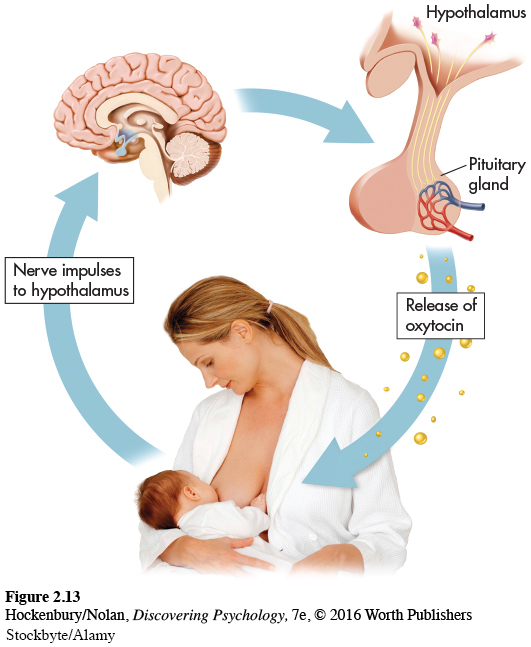
Oxytocin also has psychological effects (Carter, 2014). It promotes bonding between reproductive partners and between parent and infant, and even between dogs and owners (Nagasawa & others, 2015). Early research found that it also promotes empathy, trust among group members, and sensitivity to social cues (see Miller, 2013). These findings gave oxytocin the reputation as “the love hormone.”
MYTH SCIENCE
Is it true that oxytocin is the “love hormone,” making people more trusting and empathic?
But the effects of oxytocin are not that simple. Subsequent research found that in some circumstances, oxytocin can promote aggression or other antisocial behavior (de Dreu & others, 2011; Olff & others, 2013). For example, studies have shown that oxytocin increases bonding among group members but increases dishonest or hostile behavior toward non-
Another set of glands, called the adrenal glands, is of particular interest to psychologists. The adrenal glands consist of the adrenal cortex, which is the outer gland, and the adrenal medulla, which is the inner gland. Both the adrenal cortex and the adrenal medulla produce hormones that are involved in the human stress response. As you’ll see in Chapter 12 on stress, hormones secreted by the adrenal cortex also interact with the immune system, the body’s defense against invading viruses or bacteria.
The adrenal medulla plays a key role in the fight-
As they circulate through the bloodstream to the heart and other target organs, epinephrine and norepinephrine complement and enhance the effects of the sympathetic nervous system. These hormones also act as neurotransmitters, stimulating activity at the synapses in the sympathetic nervous system. The action of epinephrine and norepinephrine is a good illustration of the long-
Also important are the gonads, or sex organs—
Test your understanding of The Nervous and Endocrine Systems with  .
.